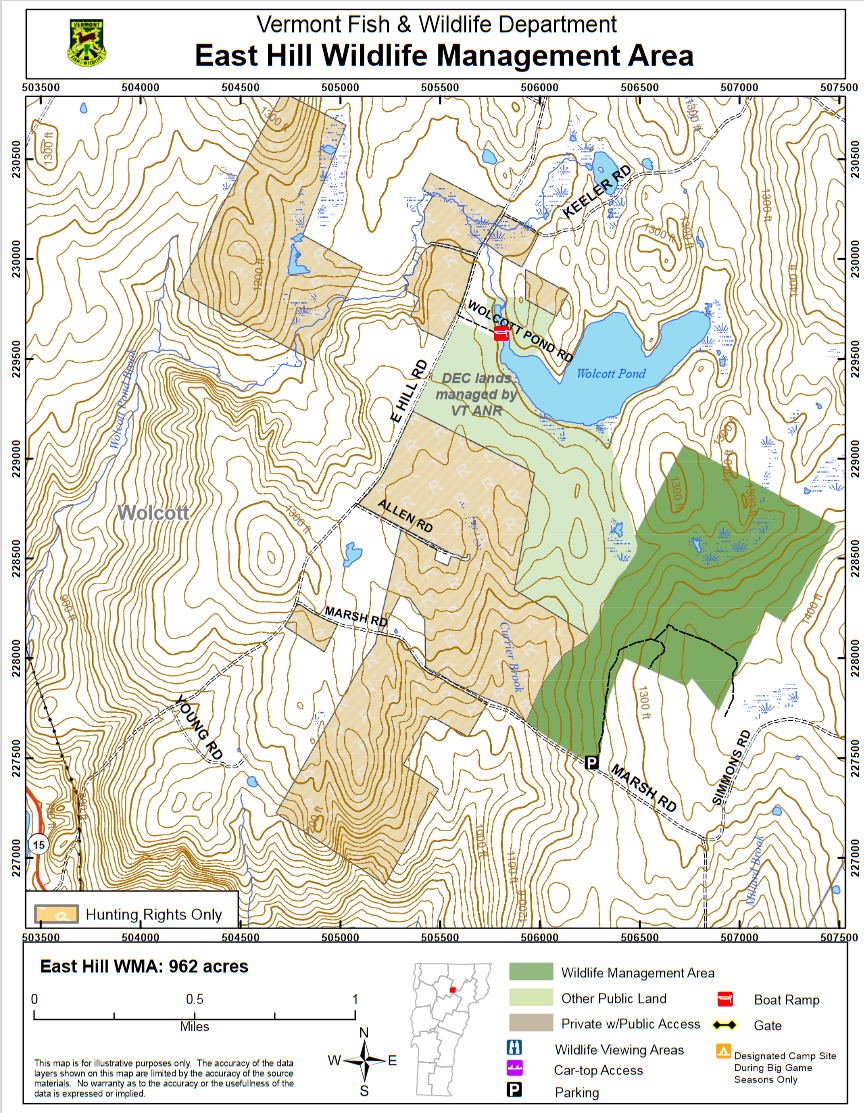East Hill WMA
Birds of Interest
Expect to find ruffed grouse, woodcock, and deciduous forest/coniferous forest-associated songbirds. Common loons are known to nest on Wolcott Pond. Many species of waterfowl can be found in the wetland and stream areas, as well as Wolcott Pond. Wood duck nesting boxes, maintained by the Department, are frequently utilized by wood ducks and hooded mergansers in the beaver-created wetlands that drain into Wolcott Pond.
About this Location
East Hill Wildlife Management Area (WMA) is located in the north-central Vermont town of Wolcott. The WMA is approximately 962 acres in size, however, only 452 of those acres are owned by the State of Vermont in fee simple (total ownership). The State of Vermont owns hunting rights only for the remaining 706 acres. The Vermont Fish and Wildlife Department manages 256 acres to the southeast of Wolcott Pond and the Vermont Department of Environmental Conservation (formerly Water Resources) manages approximately 196 acres south and east of Wolcott Pond. Wolcott Pond Access Area, managed by the Vermont Fish and Wildlife Department, is associated with the WMA and provides access to Wolcott Pond for fishing opportunities. Access to the WMA is from VT-15 and East Hill Road east of the Village of Wolcott. Developed parking lots exist on (Oral) Marsh Road before the intersection of Lafont/Simmons Road, as well as at the Wolcott Pond boating access area.
East Hill WMA lies within the Lamoille River watershed. Currier Brook bisects the southern portion of the WMA from north to south and Wolcott Pond Brook bisects the WMA from east to west.
Much of the WMA is an upland environment. The terrain is varied with rolling knolls and working farmland. There are wetland areas associated with Wolcott Pond, it’s one main inlet that comes into the pond from the southeast and its outlet is known as Wolcott Pond Brook. Beaver ponds are found along Wolcott Pond’s inlet stream.
The WMA is mostly forested with one small field located at the developed parking lot on Marsh Road and a second small field located mid-way along the eastern boundary line. Both of these fields contain apple trees. The Department periodically maintains both the fields and apple trees by brush hogging and apple tree release work. Much of the WMA consists of balsam fir and red spruce with some scattered stands of hardwoods. The coniferous portions of the WMA serve as deer wintering areas.
Features
Restrooms on site
Wheelchair accessible trail
Entrance fee
Content from East Hill Wildlife Management Area guide and map
Last updated December 3, 2023
